|
Bonnie and Clyde: A History
| Bonnie and Clyde |
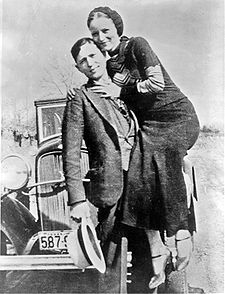
|
| Bonnie and Clyde Outlaws History |
Bonnie and Clyde (right), sometime between 1932 and 1934, posing in front
of a 1932 Ford V-8 automobile.
Introduction
Bonnie Parker (October 1, 1910 – May 23, 1934) and Clyde Barrow (March
24, 1909 – May 23, 1934) were well known outlaws, robbers, and criminals who, with their gang, traveled the Central
United States during the Great Depression. Their exploits were known nationwide. They captured the attention of the American
press and its readership during what is sometimes referred to as the "public enemy era" between 1931 and 1934. Though their
gang was notorious for their bank robberies, Barrow preferred to rob small stores or gas stations. The gang was believed to
have killed at least nine police officers and committed several other murders. They were eventually ambushed and killed in
Louisiana by law officers.
| Bonnie and Clyde Bank Robbers |
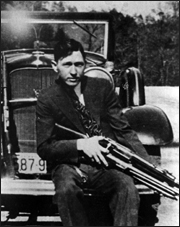
|
| Clyde Barrow |
| Bonnie and Clyde Outlaws |
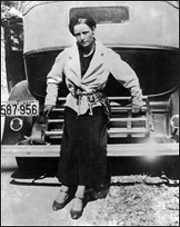
|
| Bonnie Parker |
Bonnie and Clyde were killed on May 23, 1934, on a desolate road near their
Bienville Parish, Louisiana hideout. The couple appeared in daylight in an automobile and were shot by a posse of four Texas
officers and two Louisiana officers when they attempted to drive away. Questions about the way the ambush was conducted, and
the failure to warn the duo of impending death, have been raised about the incident.
| Bonnie and Clyde Wanted Poster |
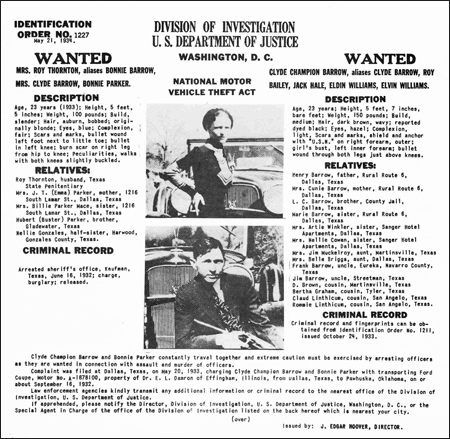
|
| Bonnie and Clyde Most Wanted Poster |
| Bonnie and Clyde |
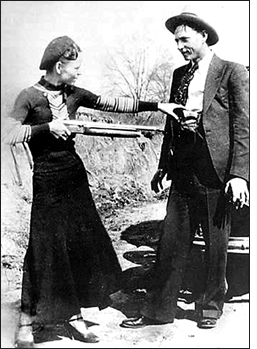
|
| Bonnie and Clyde History |
Clyde Champion Barrow and
his companion, Bonnie Parker, were shot to death by officers in an ambush near Sailes, Bienville Parish, Louisiana,
on May 23, 1934, after one of the most colorful and spectacular manhunts the Nation had seen up to that time.
Barrow was suspected of numerous
killings and was wanted for murder, robbery, and state charges of kidnapping.
The Federal Bureau of Investigation
(FBI), then called the Bureau of Investigation, became interested in Barrow and his paramour late in December, 1932, through
a singular bit of evidence. A Ford automobile, which had been stolen in Pawhuska, Oklahoma, was found abandoned near Jackson, Michigan in September of that year.
At Pawhuska, it was learned
another Ford car had been abandoned there which had been stolen in Illinois.
A search of this car revealed it had been occupied by a man and a woman, indicated by abandoned articles therein. In this
car was found a prescription bottle, which led Special Agents to a drug store in Nacogdoches,
Texas, where investigation disclosed the woman for whom the prescription had
been filled was Clyde Barrow's aunt.
Further investigation revealed
that the woman who obtained the prescription had been visited recently by Clyde Barrow, Bonnie Parker, and Clyde's
brother, L. C. Barrow. It also was learned that these three were driving a Ford car, identified as the one stolen in Illinois. It was further shown that L. C. Barrow had secured the empty
prescription bottle from a son of the woman who had originally obtained it.
| Bonnie Parker |
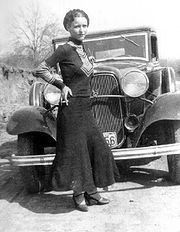
|
| Outlaw Bonnie Parker |
Bonnie Parker (left) standing
in front of a 1932 Ford V-8 B-400 Convertible Sedan.
On May 20, 1933, the United States
Commissioner at Dallas,
Texas, issued a warrant against Clyde Barrow and Bonnie Parker, charging them with the interstate
transportation, from Dallas to Oklahoma, of the automobile
stolen in Illinois. The FBI then started its hunt for this
elusive pair.
| Bonnie and Clyde |
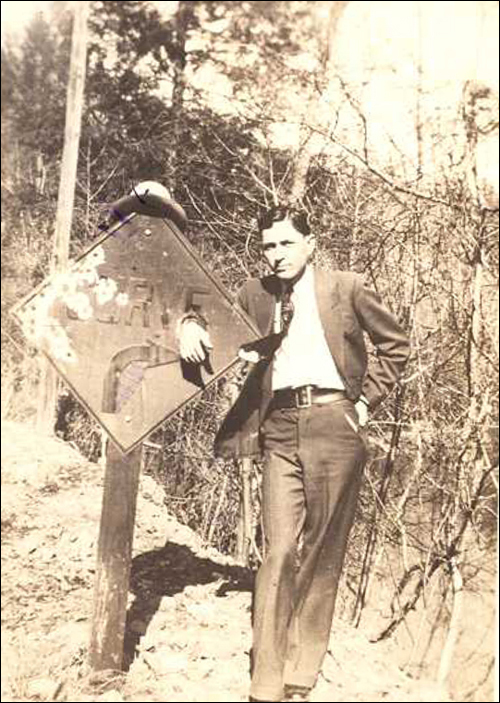
|
| Clyde Barrow poses by a road sign |
Background
Bonnie and Clyde met in
Texas
in January, 1930. At the time, Bonnie was 19 and married to an imprisoned murderer; Clyde
was 21 and unmarried. Soon after, he was arrested for a burglary and sent to jail. He escaped, using a gun Bonnie had smuggled
to him, was recaptured, and was sent back to prison. Clyde was paroled in February, 1932,
rejoined Bonnie, and resumed a life of crime.
In addition to the automobile
theft charge, Bonnie and Clyde were suspects in other crimes. At the time they were killed
in 1934, they were believed to have committed 13 murders and several robberies and burglaries. Barrow, for example, was suspected
of murdering two police officers at Joplin, Missouri, and
kidnapping a man and a woman in rural Louisiana. He released
them near Waldo, Texas. Numerous
sightings followed, linking this pair with bank robberies and automobile thefts. Clyde allegedly murdered a man at Hillsboro,
Texas; committed robberies at Lufkin and Dallas, Texas; murdered one sheriff and wounded another at Stringtown, Oklahoma;
kidnapped a deputy at Carlsbad, New Mexico; stole an automobile at Victoria, Texas; attempted to murder a deputy at Wharton,
Texas; committed murder and robbery at Abilene and Sherman, Texas; committed murder at Dallas, Texas; abducted a sheriff and
the chief of police at Wellington, Texas; and committed murder at Joplin and Columbia, Missouri.
| Clyde Most Wanted Poster |
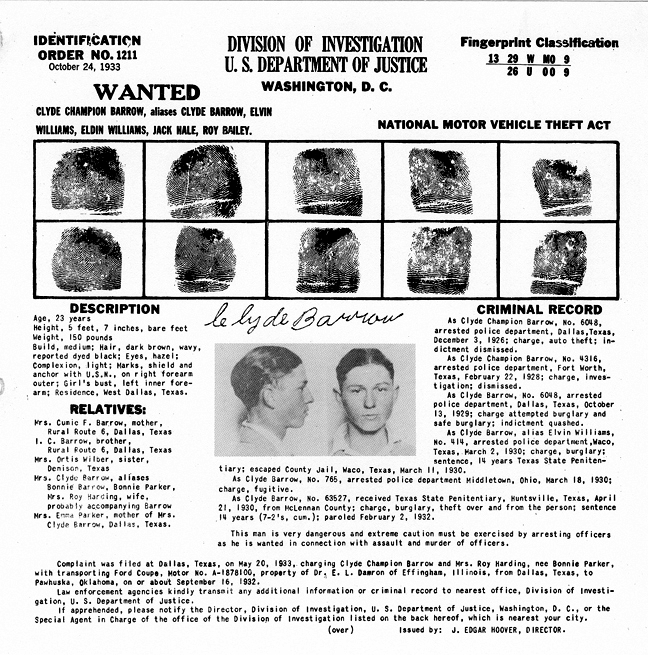
|
| Bonnie and Clyde Most Wanted Poster |
| Clyde Champion Barrow |
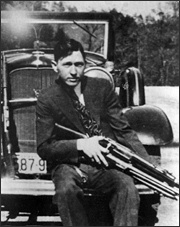
|
| Outlaw Clyde History |
The Crime Spree Begins
Later in 1932, Bonnie and
Clyde began traveling with Raymond Hamilton, a young gunman. Hamilton left them several months later, and was replaced by William Daniel Jones in November,
1932.
Ivan M. "Buck" Barrow, brother
of Clyde, was released from the Texas State Prison on March 23, 1933, having been granted
a full pardon by the Governor. He quickly joined Clyde, bringing his wife, Blanche, so the
group now numbered five persons. This gang embarked upon a series of bold robberies which made headlines across the country.
They escaped capture in various encounters with the law. However, their activities made law enforcement efforts to apprehend
them even more intense.
During a shootout with police
in Iowa on July 29, 1933, Buck Barrow was fatally wounded
and Blanche was captured. Jones, who was frequently mistaken for "Pretty Boy" Floyd, was captured in November, 1933, at Houston, Texas, by the sheriff's office.
Bonnie and Clyde went on together.
| Bonnie and Clyde Car |
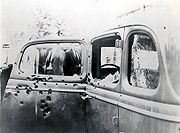
|
| "The Last Ride" in Bonnie & Clyde Car |
On November 22, 1933, a
trap was set by the Dallas,
Texas, sheriff and his deputies in an attempt to capture Bonnie and Clyde near Grand Prairie, Texas, but the couple
escaped the officer's gunfire. They held up an attorney on the highway and took his car, which they abandoned at Miami, Oklahoma. On December 21, 1933,
Bonnie and Clyde held up and robbed a citizen at Shreveport, Louisiana.
(Left) The car riddled with
bullet holes after the ambush.
On January 16, 1934, five
prisoners, including the notorious Raymond Hamilton (who was serving sentences totaling more than 200 years), were liberated
from the Eastham State Prison Farm at Waldo, Texas, by Clyde Barrow, accompanied by Bonnie Parker. Two guards were shot by
the escaping prisoners with automatic pistols, which had been previously concealed in a ditch by Barrow. As the prisoners
ran, Barrow covered their retreat with bursts of machine-gun fire. Among the escapees was Henry Methvin of Louisiana.
The Last Months
On April 1, 1934, Bonnie
and Clyde encountered two young highway patrolmen near Grapevine, Texas.
Before the officers could draw their guns, they were shot. On April 6, 1934, a constable at Miami,
Oklahoma, fell mortally wounded by Bonnie and Clyde, who
also abducted a police chief, whom they wounded.
| Bonnie and Clyde Car |
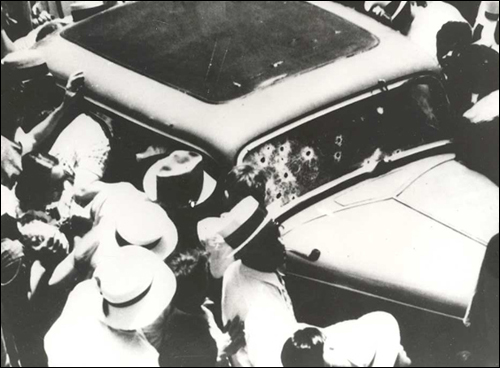
|
| A crowd gathers around Bonnie and Clyde's bullet-ridden sedan not long after the fatal ambush. |
| Bonnie Parker's Grave |
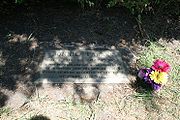
|
| Bonnie Parker Grave site |
The FBI had jurisdiction
solely on the charge of transporting a stolen automobile, although the activities of the Bureau Agents were vigorous and ceaseless.
Every clue was followed. "Wanted notices" furnishing fingerprints, photograph, description, criminal record, and other data
were distributed to all officers.
The Agents followed the
trail through many states and into various haunts of the Barrow gang, particularly Louisiana. The association with Henry Methvin and the
Methvin family of Louisiana was discovered by FBI Agents and they found that Bonnie and Clyde
had been driving a car stolen in New Orleans.
On April 13, 1934, an FBI
Agent, through investigation in the vicinity of Ruston, Louisiana,
obtained information which definitely placed Bonnie and Clyde in a remote section southwest
of that community. The home of the Methvins was not far away and the Agent learned of visits there by Bonnie and Clyde. Special Agents in Texas had learned that Clyde and his companion
had been traveling from Texas to Louisiana,
sometimes accompanied by Henry Methvin.
| Clyde and Buck Barrow's Gravesite |
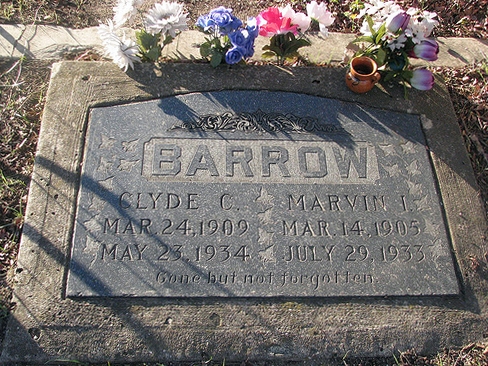
|
| Clyde Grave |
| Bonnie Parker grave |
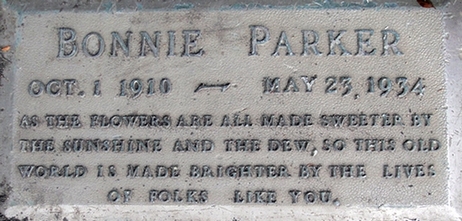
|
| Bonnie Parker gravesite |
Bonnie and Clyde wished
to be buried side by side, but the Parker family would not allow it. Parker's mother had wanted to grant her daughter's final
wish, which was to be brought home, but the mobs surrounding the Parker house made that impossible.
More than 20,000 people attended Bonnie Parker's funeral, making it difficult for her family to reach the grave site. Both
are buried in Dallas, Texas: Clyde Barrow is buried in the Western Heights Cemetery, and Bonnie Parker in the Crown Hill Memorial
Park.
The FBI and local law enforcement
authorities in Louisiana
and Texas concentrated on apprehending Bonnie and Clyde,
whom they strongly believed to be in the area. It was learned that Bonnie and Clyde, with some of the Methvins, had staged
a party at Black Lake, Louisiana, on the night of May 21, 1934, and were due to return to the area two days later.
Before dawn on May 23, 1934, a
posse composed of police officers from Louisiana and Texas,
including Texas Ranger Frank Hamer, concealed themselves in bushes along the highway near Sailes,
Louisiana. In the early daylight, Bonnie and Clyde
appeared in an automobile and when they attempted to drive away, the officers opened fire. Bonnie and Clyde
were killed instantly.
| Bonnie and Clyde |
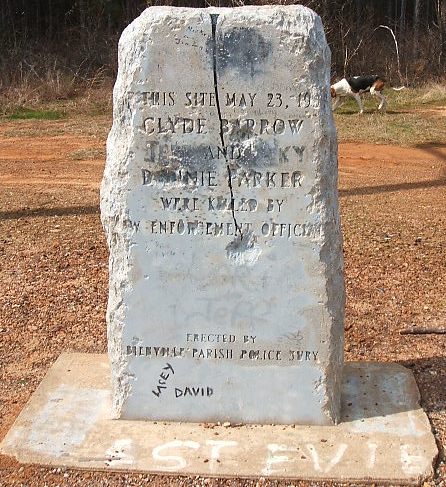
|
| Bonnie and Clyde Memorial |
The memorial at the location where Bonnie and Clyde were shot and killed in
Gibsland Louisiana.
(Sources listed at bottom of page)
Sources: fbi.gov; Library of Congress;
National Archives; Barrow, Blanche Caldwell and John Neal Phillips. My
Life with Bonnie and Clyde.
(University of Oklahoma Press,
2004); Cartledge, Rick. The Guns of Frank Hamer; DeFord, Miriam Allen. The Real Bonnie and Clyde.
Sphere Books, 1968; Guinn, Jeff. Go Down Together: The True, Untold Story of Bonnie and Clyde.
Simon & Schuster, 2009; King, Betty Nygaard. Hell Hath No Fury: Famous Women in Crime (Borealis Press, 2001); Knight,
James R. and Jonathan Davis. Bonnie and Clyde: A Twenty-First-Century Update. Eakin Press,
2003; Matteson, Jason. Texas Bandits: A Study of the 1948
Democratic Primary; Milner, E.R. The Lives and Times of Bonnie and Clyde (Carbondale and
Edwardsville, Southern Illinois University Press, 1996); Phillips, John Neal. Running with Bonnie and Clyde,
the Ten Fast Years of Ralph Fults. (University of Oklahoma Press, 1996, 2002)
Tags: Bonnie and Clyde Outlaws Bonnie Parker Clyde Barrow History Famous Outlaws Bank Robbers Barrow Gang
Criminals Infamous Outlaw Biography Bank Robbery Ranger Texas Dallas Louisiana Ranger Legend FBI Crime Spree Bonnie and Clyde, Outlaws Bonnie Parker Clyde Barrow History, Famous Outlaws How Bonnie Clyde Died Killed Where When
Texas Dallas Infamous Outlaw Biography Death Robbery Bank Robberies Location Facts Murder Robberies Murders
|

